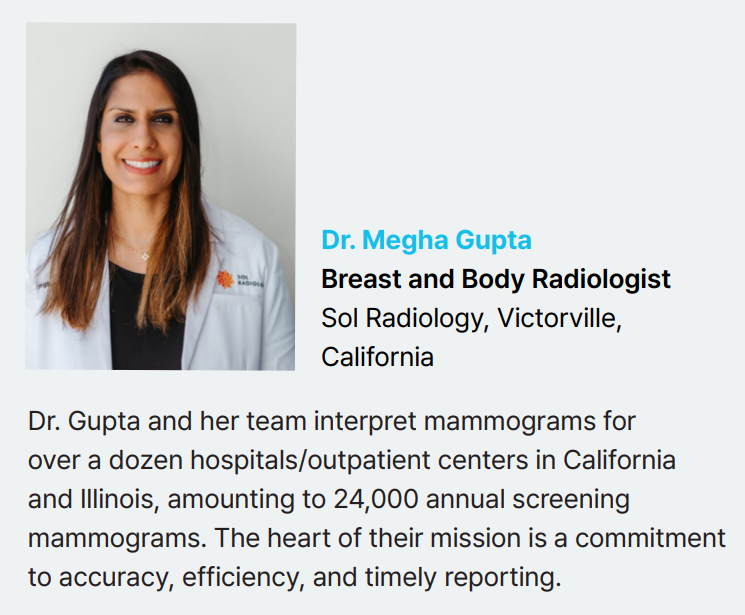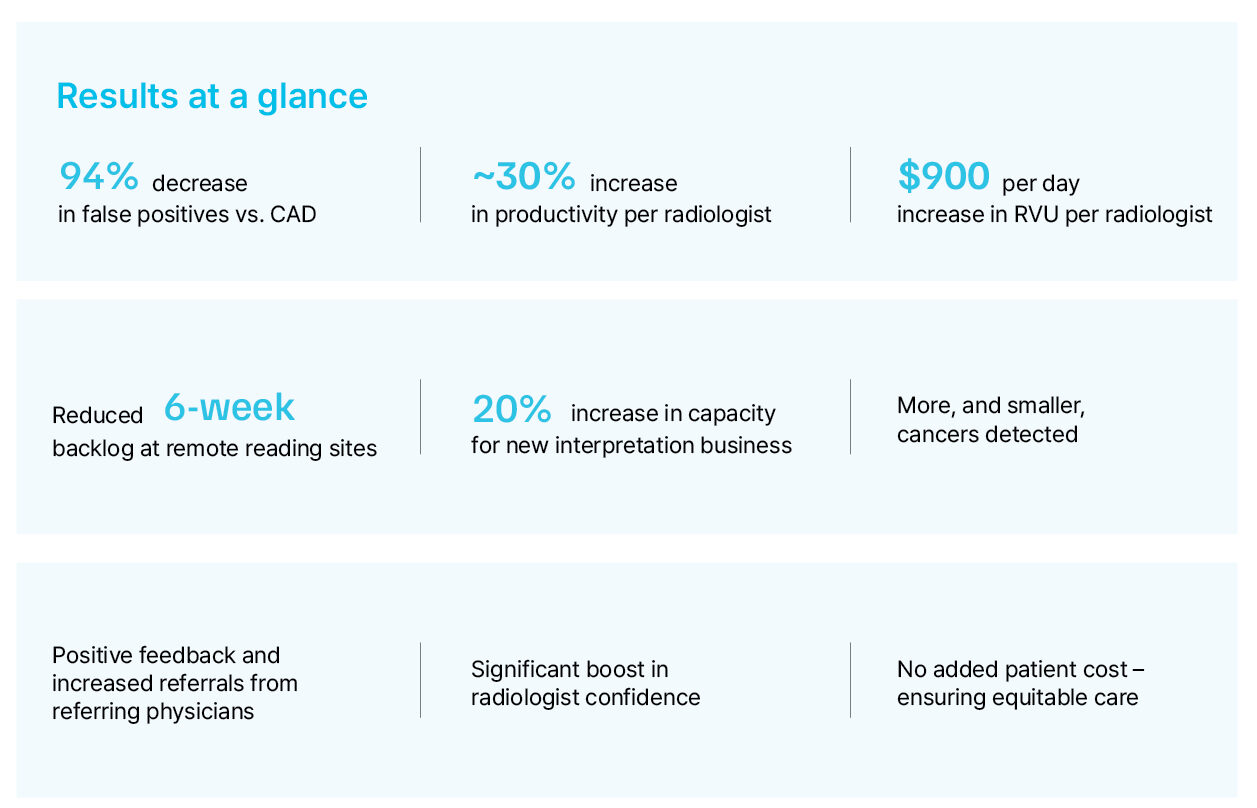The Ripple Effect of AI: Faster Reads, Stronger Referrals, and Smaller Cancers Detected
For Dr. Megha Gupta, Lunit INSIGHT isn’t just artificial intelligence, it’s a solution that has transformed her breast imaging practice and is making a real difference in patients’ lives. The radiologists at Sol Radiology in Victorville, California, faced challenges that resonate with many centers: a relentless backlog of mammograms, radiologist shortages, and constant pressure to detect breast cancers as early as possible.
Dr. Gupta looked to AI for answers. She did her research and landed on Lunit INSIGHT as the AI partner that could help her team keep pace without sacrificing care. The results are striking
Weight and volume of false positives

Before implementing AI, the practice relied on traditional CAD systems, which often cluttered their screens with excessive markings and false positives. This not only slowed down reading times but also added stress to their high volume reading environment. Implementing Lunit INSIGHT reduced false positives by 94% and allowed them to focus on what truly matters: identifying cancers early.
Workflow impact and efficiency gains
Lunit INSIGHT fundamentally reshaped their reading process. The AI software provides an intuitive interface, with abnormality scores and color mapping to help quickly assess risk. The solution is proven to be highly precise, displaying findings that are most likely to represent cancer, which helps radiologists prioritize which mammograms need their immediate attention.
With the help of AI, Dr. Gupta changed her workflow to look at cases with abnormal scores first, which helps her target areas flagged as concerning and scroll faster through negative studies. “This streamlined reading process helped me cut my reading time by 50%. I’m reading the most urgent mammograms first and it has made me a faster, more confident radiologist”, said Dr. Gupta. This efficient process also helped the team quickly work through a 6-week backlog at a number of their remote reading sites. The time saved was so significant, it unlocked an additional 20% capacity to take on new interpretation business.
Beyond speeding up their reading process, productivity increased by roughly 30% per radiologist. This productivity gain translates into additional revenue for the practice as tracked by RVUs (relative value units – which form the basis for payment of physician fees by Medicare and other payors). They currently estimate a $900 per day RVU increase per radiologist, which translates to an astounding $600,000 annually
A trusted partner: What made the biggest difference in choosing an AI solution? Trust.
Dr. Gupta emphasizes the importance of choosing AI that is built on large, diverse, high-quality datasets and proven to work in clinical practice. This trust was rewarded: AI highlighted subtle lesions, improved evaluation of dense breasts, and helped radiologists detect cancers earlier – boosting confidence across the team.
Referring physicians and community impact
Perhaps the most powerful impact is seen in patient care and relationships with referring physicians. Since adopting AI, Sol Radiology has been able to detect smaller cancers, including a memorable case where a subtle, 4mm cancer was found that likely would otherwise have been missed. Referring doctors, particularly primary care physicians and breast surgeons,
have noticed these earlier detections and have shared their appreciation.
“They tell me: you’re finding the smallest cancers we didn’t see before. It’s making a real difference,” Dr. Gupta recounted. These successes have strengthened trust, increased referrals
to their center, and directly benefited patients: smaller cancers often mean less invasive treatment, lower costs, and better prognoses.
Analyzing the impact for Sol Radiology
In numbers, the transformation is striking: a 94% reduction in false positives compared to CAD; a ~30% boost in productivity; higher radiologist confidence – especially when
interpreting dense breast tissue; more small cancers detected earlier; and more referrals and higher trust among local providers. The center does not charge patients for AI, ensuring equitable access and highlighting their commitment to community care.

“With AI, we’re not just reading images faster – we’re changing lives.”
— Dr. Megha Gupta
Keys to successful implementation
Reflecting on the journey, Dr. Gupta highlights several lessons for those considering Lunit INSIGHT – building trust in the AI tool is critical; she and her team chose an AI partner known for the quality of their diverse and robust training data. Investing in thorough training for her team ensured they could use every feature to its full potential. Just as important was educating referring physicians and patients about AI’s supportive role, reinforcing that final decisions remain with experienced radiologists.
Finally, Dr. Gupta emphasized tracking cases where AI changed decision making to continually build confidence in its value.
Learn how Sol Radiology used Lunit INSIGHT to streamline workflows and clear their backlog with remarkable speed. Clearing a Month-Long Mammography Report Backlog in Just Days – Volpara Health


